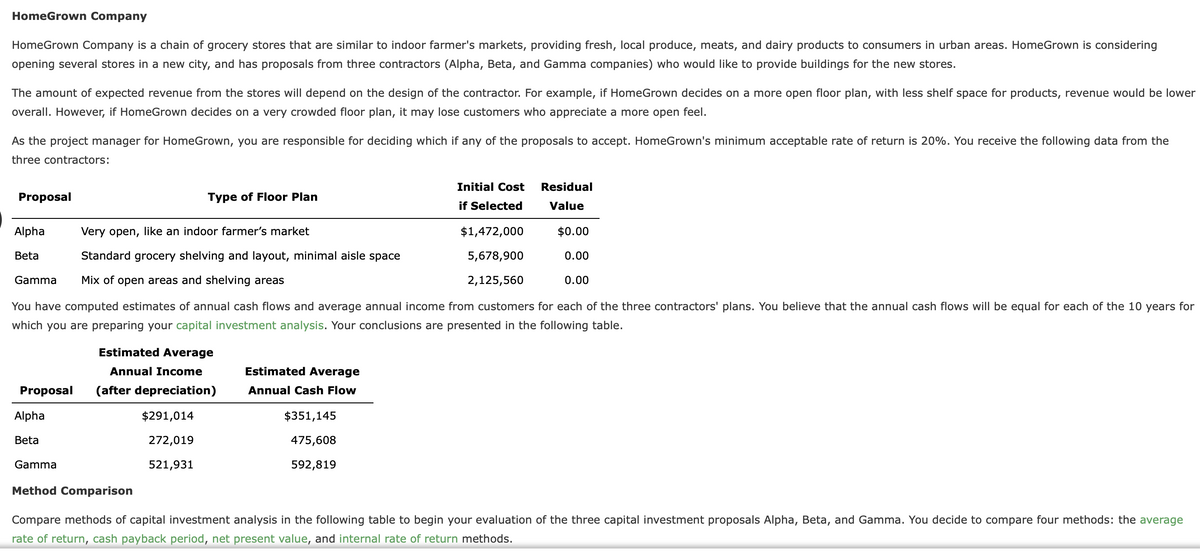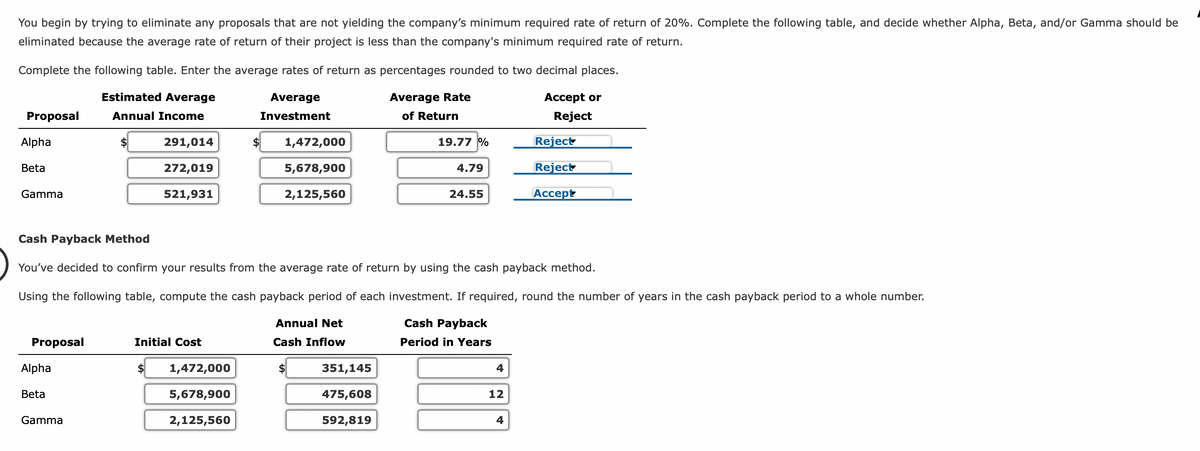Hello! Please help me with as much of this as you can. Thank you! Present Value of an Annuity of $1 at Compound Interest (Partial Table) Year 10% 20% 1 0.909 0.833 5 3.791 2.991 10 6.145 4.192 Alpha Beta Gamma Annual net cash flow $fill in the blank 7f0ece094062012_1 $fill in the blank 7f0ece094062012_2 $fill in the blank 7f0ece094062012_3 Present value factor fill in the blank 7f0ece094062012_4 fill in the blank 7f0ece094062012_5 fill in the blank 7f0ece094062012_6 Present value of annual net cash flows $fill in the blank 7f0ece094062012_7 $fill in the blank 7f0ece094062012_8 $fill in the blank 7f0ece094062012_9 Amount to be invested fill in the blank 7f0ece094062012_10 fill in the blank 7f0ece094062012_11 fill in the blank 7f0ece094062012_12 Net present value $fill in the blank 7f0ece094062012_13 $fill in the blank 7f0ece094062012_14 $fill in the blank 7f0ece094062012_15 Question Content Area Final Questions After reviewing all your data, answer the following questions (1)-(3). 1. What can you say about each proposal? (<, =, > 20%) Proposal Internal Rate of Return Alpha Beta Gamma 2. What can you say about these proposals? (A, B, C, A and B, B and C) a. HomeGrown would be breaking even (i.e., profit = 0) if Alpha’s proposal is chosen. b. Only Gamma’s proposal is yielding more than HomeGrown’s minimum desired rate of return. c. Gamma’s proposal is the only proposal that would be acceptable to HomeGrown. 3. Which proposal is the best choice for HomeGrown given the data collected?
Hello! Please help me with as much of this as you can. Thank you! Present Value of an Annuity of $1 at Compound Interest (Partial Table) Year 10% 20% 1 0.909 0.833 5 3.791 2.991 10 6.145 4.192 Alpha Beta Gamma Annual net cash flow $fill in the blank 7f0ece094062012_1 $fill in the blank 7f0ece094062012_2 $fill in the blank 7f0ece094062012_3 Present value factor fill in the blank 7f0ece094062012_4 fill in the blank 7f0ece094062012_5 fill in the blank 7f0ece094062012_6 Present value of annual net cash flows $fill in the blank 7f0ece094062012_7 $fill in the blank 7f0ece094062012_8 $fill in the blank 7f0ece094062012_9 Amount to be invested fill in the blank 7f0ece094062012_10 fill in the blank 7f0ece094062012_11 fill in the blank 7f0ece094062012_12 Net present value $fill in the blank 7f0ece094062012_13 $fill in the blank 7f0ece094062012_14 $fill in the blank 7f0ece094062012_15 Question Content Area Final Questions After reviewing all your data, answer the following questions (1)-(3). 1. What can you say about each proposal? (<, =, > 20%) Proposal Internal Rate of Return Alpha Beta Gamma 2. What can you say about these proposals? (A, B, C, A and B, B and C) a. HomeGrown would be breaking even (i.e., profit = 0) if Alpha’s proposal is chosen. b. Only Gamma’s proposal is yielding more than HomeGrown’s minimum desired rate of return. c. Gamma’s proposal is the only proposal that would be acceptable to HomeGrown. 3. Which proposal is the best choice for HomeGrown given the data collected?
Cornerstones of Cost Management (Cornerstones Series)
4th Edition
ISBN:9781305970663
Author:Don R. Hansen, Maryanne M. Mowen
Publisher:Don R. Hansen, Maryanne M. Mowen
Chapter7: Allocating Costs Of Support Departments And Joint Products
Section: Chapter Questions
Problem 17E
Related questions
Question
Hello! Please help me with as much of this as you can. Thank you!
| Present Value of an at |
||
| Year | 10% | 20% |
| 1 | 0.909 | 0.833 |
| 5 | 3.791 | 2.991 |
| 10 | 6.145 | 4.192 |
| Alpha | Beta | Gamma | |
| Annual net cash flow | $fill in the blank 7f0ece094062012_1 | $fill in the blank 7f0ece094062012_2 | $fill in the blank 7f0ece094062012_3 |
| Present value factor | fill in the blank 7f0ece094062012_4 | fill in the blank 7f0ece094062012_5 | fill in the blank 7f0ece094062012_6 |
| Present value of annual net cash flows | $fill in the blank 7f0ece094062012_7 | $fill in the blank 7f0ece094062012_8 | $fill in the blank 7f0ece094062012_9 |
| Amount to be invested | fill in the blank 7f0ece094062012_10 | fill in the blank 7f0ece094062012_11 | fill in the blank 7f0ece094062012_12 |
| $fill in the blank 7f0ece094062012_13 | $fill in the blank 7f0ece094062012_14 | $fill in the blank 7f0ece094062012_15 |
Question Content Area
Final Questions
After reviewing all your data, answer the following questions (1)-(3).
1. What can you say about each proposal? (<, =, > 20%)
Proposal |
of Return |
| Alpha |
|
| Beta |
|
| Gamma |
|
2. What can you say about these proposals? (A, B, C, A and B, B and C)
a. HomeGrown would be breaking even (i.e., profit = 0) if Alpha’s proposal is chosen.
b. Only Gamma’s proposal is yielding more than HomeGrown’s minimum desired rate of return.
c. Gamma’s proposal is the only proposal that would be acceptable to HomeGrown.
3. Which proposal is the best choice for HomeGrown given the data collected?

Transcribed Image Text:HomeGrown Company
HomeGrown Company is a chain of grocery stores that are similar to indoor farmer's markets, providing fresh, local produce, meats, and dairy products to consumers in urban areas. HomeGrown is considering
opening several stores in a new city, and has proposals from three contractors (Alpha, Beta, and Gamma companies) who would like to provide buildings for the new stores.
The amount of expected revenue from the stores will depend on the design of the contractor. For example, if HomeGrown decides on a more open floor plan, with less shelf space for products, revenue would be lower
overall. However, if HomeGrown decides on a very crowded floor plan, it may lose customers who appreciate a more open feel.
As the project manager for HomeGrown, you are responsible for deciding which if any of the proposals to accept. HomeGrown's minimum acceptable rate of return is 20%. You receive the following data from the
three contractors:
Proposal
Alpha
Beta
Gamma
Alpha
Beta
Type of Floor Plan
Very open, like an indoor farmer's market
Standard grocery shelving and layout, minimal aisle space
Mix of open areas and shelving areas
Estimated Average
Annual Income
Proposal (after depreciation)
$291,014
272,019
521,931
Gamma
Method Comparison
You have computed estimates of annual cash flows and average annual income from customers for each of the three contractors' plans. You believe that the annual cash flows will be equal for each of the 10 years for
which you are preparing your capital investment analysis. Your conclusions are presented in the following table.
Estimated Average
Annual Cash Flow
Initial Cost
if Selected
$351,145
475,608
592,819
$1,472,000
5,678,900
2,125,560
Residual
Value
$0.00
0.00
0.00
Compare methods of capital investment analysis in the following table to begin your evaluation of the three capital investment proposals Alpha, Beta, and Gamma. You decide to compare four methods: the average
rate of return, cash payback period, net present value, and internal rate of return methods.

Transcribed Image Text:You begin by trying to eliminate any proposals that are not yielding the company's minimum required rate of return of 20%. Complete the following table, and decide whether Alpha, Beta, and/or Gamma should be
eliminated because the average rate of return of their project is less than the company's minimum required rate of return.
Complete the following table. Enter the average rates of return as percentages rounded to two decimal places.
Estimated Average
Average
Average Rate
Accept or
Proposal
Annual Income
Investment
of Return
Reject
#볼링종목
Alpha
$
291,014
$ 1,472,000
19.77 %
Reject
Beta
272,019
5,678,900
4.79
Reject
Gamma
521,931
2,125,560
24.55
Accept
Cash Payback Method
You've decided to confirm your results from the average rate of return by using the cash payback method.
Using the following table, compute the cash payback period of each investment. If required, round the number of years in the cash payback period to a whole number.
Cash Payback
Period in Years
Proposal
Alpha
Beta
Gamma
Initial Cost
$
1,472,000
5,678,900
2,125,560
Annual Net
Cash Inflow
$
351,145
475,608
592,819
12
4
Expert Solution
This question has been solved!
Explore an expertly crafted, step-by-step solution for a thorough understanding of key concepts.
Step by step
Solved in 2 steps with 1 images

Knowledge Booster
Learn more about
Need a deep-dive on the concept behind this application? Look no further. Learn more about this topic, finance and related others by exploring similar questions and additional content below.Recommended textbooks for you

Cornerstones of Cost Management (Cornerstones Ser…
Accounting
ISBN:
9781305970663
Author:
Don R. Hansen, Maryanne M. Mowen
Publisher:
Cengage Learning

Essentials of Business Analytics (MindTap Course …
Statistics
ISBN:
9781305627734
Author:
Jeffrey D. Camm, James J. Cochran, Michael J. Fry, Jeffrey W. Ohlmann, David R. Anderson
Publisher:
Cengage Learning

Survey of Accounting (Accounting I)
Accounting
ISBN:
9781305961883
Author:
Carl Warren
Publisher:
Cengage Learning

Cornerstones of Cost Management (Cornerstones Ser…
Accounting
ISBN:
9781305970663
Author:
Don R. Hansen, Maryanne M. Mowen
Publisher:
Cengage Learning

Essentials of Business Analytics (MindTap Course …
Statistics
ISBN:
9781305627734
Author:
Jeffrey D. Camm, James J. Cochran, Michael J. Fry, Jeffrey W. Ohlmann, David R. Anderson
Publisher:
Cengage Learning

Survey of Accounting (Accounting I)
Accounting
ISBN:
9781305961883
Author:
Carl Warren
Publisher:
Cengage Learning


Managerial Accounting: The Cornerstone of Busines…
Accounting
ISBN:
9781337115773
Author:
Maryanne M. Mowen, Don R. Hansen, Dan L. Heitger
Publisher:
Cengage Learning